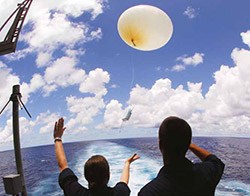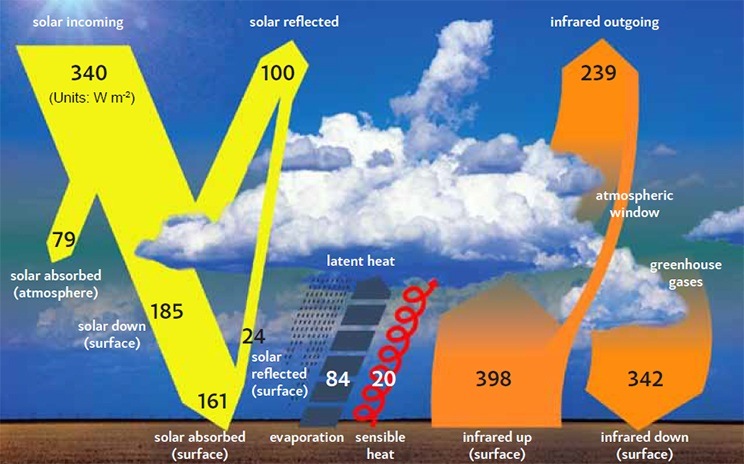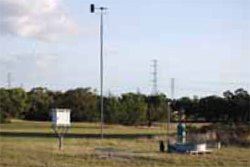
 by Kyle D. Gahlau
by Kyle D. GahlauWeather is the state of the atmosphere—its temperature, humidity, wind, rainfall and so on—over hours to weeks. It is influenced by the oceans, land surfaces and ice sheets, which together with the atmosphere form what is called the ‘climate system’. Climate, in its broadest sense, is the statistical description of the state of the climate system.
Climate change is a change in the statistical properties of the climate system that persists for several decades or longer—usually at least 30 years. These statistical properties include averages, variability and extremes. Climate change may be due to natural processes, such as changes in the Sun’s radiation, volcanoes or internal variability in the climate system, or due to human influences such as changes in the composition of the atmosphere or land use.
Weather can be forecast with considerable skill up to about a week in advance. Short term fluctuations in climate, such as droughts, can be predicted with limited skill from season to season. In contrast, changes in the long-term statistics of the climate system (climate change) can be predicted if caused by long-term influences that are known or predictable (Box 1.1).
The challenges of predicting weather and climate are very different. Predicting the weather is like predicting how a particular eddy will move and evolve in a turbulent river: it is possible over short time scales by extrapolating the previous path of the eddy, but eventually the eddy is influenced by neighbouring eddies and currents to the extent that predicting its exact path and behaviour becomes impossible. Similarly, the limit for predicting individual weather systems in the atmosphere is around 10 days. On the other hand, predicting climate is like predicting the flow of the whole river. It requires a consideration of the major forces controlling the river such as changes in rainfall, the operation of dams, and extraction of water. Projections of human-induced climate change over decades to centuries are possible because human activities have predictable effects on the future atmospheric composition, and in turn a predictable effect on climate.
Energy from the Sun is the ultimate driver of climate on Earth. The solar energy received by Earth depends on how much the Sun emits and the distance between Earth and the Sun. Part of this sunlight is reflected directly back to space by the atmosphere, clouds, and land, ice and water surfaces. Aerosols (tiny particles in the atmosphere, some coming from human activities) can increase the reflection of sunlight.
Eventually the solar energy absorbed by Earth is returned to space as infrared (heat) radiation. In the process it interacts with the whole climate system—atmosphere, oceans, land surfaces and ice sheets. The flows of radiation in the atmosphere (Figure 1.1) are very important in determining climate. The main gases that make up the atmosphere, nitrogen and oxygen, do not interact with infrared radiation. However, certain gases present in smaller quantities absorb infrared radiation flowing upwards from Earth’s surface and re-radiate it in all directions, including back downwards. By doing this they impede the outward flow of infrared energy from Earth to space. This is called the ‘greenhouse effect’, and the gases that cause it by interacting with infrared radiation are called greenhouse gases. The most important are water vapour, carbon dioxide (CO2) and methane. The greenhouse effect was identified more than a century ago; Earth’s surface would be about 33°C cooler without it, so it keeps Earth habitable.

Global climate varies naturally over time scales from decades to thousands of years and longer. These natural variations can originate in two ways: from internal fluctuations that exchange energy, water and carbon between the atmosphere, oceans, land and ice, and from external influences on the climate system, including variations in the energy received from the sun and the effects of volcanic eruptions.
Human activities can also influence climate by changing concentrations of CO2 and other greenhouse gases in the atmosphere (Box 1.2), altering the concentrations of aerosols and altering the reflectivity of Earth’s surface by changing land cover.
Today, human activities are directly increasing atmospheric concentrations of CO2, methane and nitrous oxide, plus some chemically manufactured greenhouse gases such as halocarbons (Question 3). These humangenerated gases enhance the natural greenhouse effect and further warm the surface. In addition to the direct effect, the warming that results from increased concentrations of long-lived greenhouse gases can be amplified by other processes. A key example is water vapour amplification (Box 1.3). Human activities are also increasing aerosols in the atmosphere, which reflect some incoming sunlight. This human-induced change offsets some of the warming from greenhouse gases.

There are close connections between temperature, atmospheric water vapour, the extent of polar ice sheets and the concentrations of long-lived greenhouse gases (especially CO2) in the atmosphere.
When one of these is disturbed, the others react through ‘feedback’ processes that may amplify or dampen the original disturbance. These feedbacks occur on a wide range of time scales: those involving the atmosphere are typically rapid, while those involving deep oceans and ice sheets are slow and can cause delayed responses.
An example of a rapid feedback is the role of water vapour as explained in Box 1.3. An example of a slow feedback is the ice age cycles that have taken place over the past million years, triggered by fluctuations in Earth’s rotation and orbit around the sun. These fluctuations changed the distribution of solar radiation received by Earth, which caused temperatures to change, in turn inducing changes in ice sheets and carbon cycling that together amplified the temperature response. (Question 2).
Water vapour accounts for about half the natural greenhouse effect. Its concentrations in the atmosphere are controlled mainly by atmospheric temperatures and winds, in contrast with the concentrations of other greenhouse gases which are directly influenced by human-induced inputs of these gases to the atmosphere. When global average atmospheric temperatures rise, global water vapour concentrations increase, amplifying the initial warming through an enhanced greenhouse effect. In this way, human activity leads indirectly to increases in water vapour concentrations.
The reality of the water vapour feedback is supported by recent observations and analyses. Increased water vapour concentrations have been observed and attributed to warming, and this feedback approximately doubles the sensitivity of climate to human activities.
© 2026 Australian Academy of Science